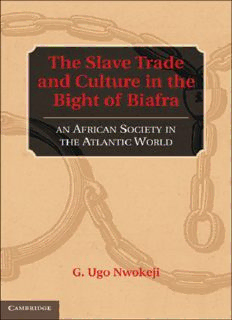
The Slave Trade and Culture in the Bight of Biafra: An African Society in the Atlantic World PDF
Preview The Slave Trade and Culture in the Bight of Biafra: An African Society in the Atlantic World
The Slave Trade and Culture in the Bight of Biafra The Slave Trade and Culture in the Bight of Biafra dissects and explains the structure, dramatic expansion, and manifold effects of the slave trade in the Bight of Biafra. By showing that the rise of the Aro merchant group was the key factor in trade expansion, G. Ugo Nwokeji reinterprets why and how such large-scale commerce developed in the absence of large-scale centralized states. The result is the fi rst study to link the structure and trajectory of the slave trade in a major exporting region to the expansion of a specifi c African merchant group – among other fresh insights into Atlantic Africa’s involvement in the trade – and the most comprehensive treatment of Atlantic slave trade in the Bight of Biafra. The fundamental role of culture in the organization of trade is highlighted, transcending the usual economic explanations in a way that complicates traditional generalizations about work, domestic slavery, and gender in precolonial Africa. G. Ugo Nwokeji is assistant professor of African American studies at the University of California, Berkeley. His research focuses on the cultural history and political economy of Africa since 1500, with par- ticular focus on international commerce in the Nigerian Niger Delta and its hinterland. Professor Nwokeji is the author of the James A. Baker III Institute for Public Policy’s T he Nigerian National Petroleum Corporation and the Development of the Nigerian Oil and Gas Industry: History, Strategies, and Current Directions (2007) and multi- ple journal articles and book chapters, as well as co-editor of R eligion, History and Politics in Nigeria (2005). The Slave Trade and Culture in the Bight of Biafra An African Society in the Atlantic World G. UGO NWOKEJI University of California, Berkeley cambridge university press Cambridge, New York, Melbourne, Madrid, Cape Town, Singapore, São Paulo, Delhi, Dubai, Tokyo, Mexico City Cambridge University Press 32 Avenue of the Americas, N ew York, ny 10013-2473, usa www.cambridge.org Information on this title: w ww.cambridge.org/ 9780521883474 © G. Ugo Nwokeji 2010 This publication is in copyright. Subject to statutory exception and to the provisions of relevant collective licensing agreements, no reproduction of any part may take place without the written permission of Cambridge University Press. First published 2 010 Printed in the United States of America A catalog record for this publication is available from the British Library. Library of Congress Cataloging in Publication data Nwokeji, G. Ugo. T he slave trade and culture in the Bight of Biafra: an African society in the Atlantic world / G. Ugo Nwokeji. p. cm. isbn 978-0-521-88347-4 (hardback) 1. Slave trade – Biafra, Bight of, Region – History. 2. Slavery – Biafra, Bight of, Region – History. 3. Biafra, Bight of, Region – Social conditions. I. Title. ht1334.b5n87 2010 306.3′620916373–dc22 2010021039 isbn 978-0-521-88347-4 Hardback Cambridge University Press has no responsibility for the persistence or accuracy of urls for external or third-party Internet Web sites referred to in this publication and does not guarantee that any content on such Web sites is, or will remain, accurate or appropriate. This book is dedicated to the memory of Don Ohadike, historian and gentleman Contents List of Tables and Figures page ix Map of the Bight of Biafra and Its Hinterland xi Preface xiii Foreword by Paul E. Lovejoy xxiii 1 Introduction 1 2 The Aro in the Atlantic Context: Expansion and Shifts, 1600s–1807 22 3 The Trade Diaspora in Regional Context: Aro Commercial Organization in the Era of Expansion, 1740–1850 53 4 Culture Formation in the Trading Frontier, c. 1740 to c. 1850 82 5 Household and Market Persons: Deportees and Society, c. 1740–c. 1850 117 6 The Slave Trade, Gender, and Culture 144 7 Cultural and Economic Aftershocks 178 8 Summary and Conclusions 204 Notes on Sources 209 Sources Cited 223 Index 265 vii Tables and Figures Tables 0.1. Estimated Volume of Biafra Captive Exports, 1551–1850, by Twenty-Five-Year Period page xiv 2.1. Estimated Volume of the Transatlantic Captive Departures from the Bight of Biafra and All African Regions Combined, Primarily Five-Year Intervals, 1531–1740 33 2.2. A Sample of Captive Prices (in Copper Bars) in New Calabar and Old Calabar, 1678–1704 36 2.3. The Volume of the Transatlantic Captive Departures from the Bight of Biafra and All African Regions Combined, Five-Year Intervals, 1701–1805 38 2.4. Time Spent by Ships at African Ports, 1751–1800 39 2.5. Daily Average Number of Captives Loaded Per Vessel, 1701–50 41 2.6. Daily Average Number of Captives Loaded Per Vessel, 1751–1800 41 2.7. Estimated Departures of Captives from Bight of Biafra Ports by Quarter Century, 1651–1850 (in thousands) 46 3.1. Division of Spheres among Aro Lineage-Groups 61 3.2. Principal Aro Settlements at the Edge of the Igbo Heartland 62 ix
Description: